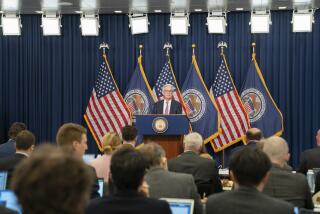Watchdog cites lack of disclosure on TARP
- Share via
WASHINGTON — As the watchdog of the government’s massive bailout of the financial sector, Neil M. Barofsky had a simple question: What had the nation’s banks done with all their bailout money?
Can’t be answered, said the Treasury Department, because of the way banks move money internally. The department declined to put the question to the banks.
And so Barofsky started asking financial institutions himself, getting answers from more than 300 that had received federal bailout money and learning to what extent they had used the money to increase their lending, buy competitors or build their cash reserves.
The banking survey, and the refusal of Treasury officials to conduct it themselves, were revealed as Barofsky issued a stinging report Monday that complained of a lack of transparency in the Obama administration’s management of the giant financial services bailout program.
The report came as critics of the administration said that the White House has fallen short of its promises to run a more open government. Among other areas, the critics cite the president’s conduct of the healthcare debate, which has included closed-door White House meetings with powerful interest groups.
“You can’t ask the basic questions or have a debate about the fundamental policy questions without information,” Barofsky said in an interview.
Increased transparency was a campaign pledge Obama made at every turn during the election campaign. As president, he said he would invite television cameras into the negotiating sessions over healthcare. C-SPAN would record every word, Obama said, while he and members of Congress, as well as representatives of healthcare industry, hashed out a plan to overhaul the nation’s healthcare system.
The discussions have not played out that way. Obama has met repeatedly in the White House with congressional leaders to discuss healthcare strategy. No cameras or reporters have been allowed to cover the talks. The White House has announced deals with hospital and drug industry executives -- negotiated behind closed doors -- as part of its push to revamp healthcare.
“We think the record is mixed on transparency,” said Melanie Sloan, executive director of Citizens for Responsibility and Ethics in Washington. “They’ve promised more than they’ve delivered, and we’ve been disappointed. But it’s seven months in, it’s early, and we hope they can get it right.”
Linda Douglass, a spokeswoman for the White House, said the Obama administration is disclosing far more than its predecessors.
“The public has had much more of a window on the process of discussing these things with various interest groups than they’ve ever had before,” Douglass said. “It could be that some meetings have certainly been in a private setting, but I don’t know if the president had promised that every single conversation he has everywhere would be webcast.”
Ellen Miller, executive director of the Sunlight Foundation, a nonprofit group that focuses on government transparency, credited the Obama administration for making more government data public. The website data.gov, for example, represents a genuine attempt to put a wealth of government information on the Internet, she said.
But at the same time, Miller said: “We don’t see any radical changes from what we’ve seen in the past.”
Advocates for open government have been distressed by Obama’s announcement in May that he would block the release of photos showing U.S. troops mistreating prisoners in Iraq. They also criticized his efforts to conceal the names of visitors to the White House.
Barofsky, whose title is special inspector general for the Troubled Asset Relief Program, or TARP, said disclosing information to the public was important to the success of the bailout program.
“It’s necessary so that taxpayers know what’s going on with their money,” he said. Without it, government risks encouraging corruption “and an erosion of confidence in the TARP and the Treasury.”
A Treasury spokesman said that parts of the report were exaggerated and that the department had studied all of Barofsky’s recommendations and adopted many of them.
Barofsky’s survey of 364 financial institutions found that about 43% said they used some of the funds to build up reserves. Fifty-two percent said they used some of the funds for debt repayment, and 15% used the money for acquisitions.
All told, 83% of the financial institutions said they used some of the funds for lending.
Although there was no effort to verify the reports, Barofsky said the survey provided a useful picture of how funds were used.
The data, along with the transparency concerns Barofsky expressed in his report, will be discussed at a hearing today before the Committee on Oversight and Government Reform.
The ranking Republican on that committee, Rep. Darrell E. Issa (R-Vista) said in a statement released Monday that when it comes to promises of openness, the Obama administration is “falling far short.”
--
peter.nicholas@latimes.com
More to Read
Sign up for Essential California
The most important California stories and recommendations in your inbox every morning.
You may occasionally receive promotional content from the Los Angeles Times.










